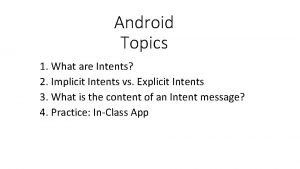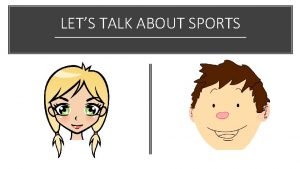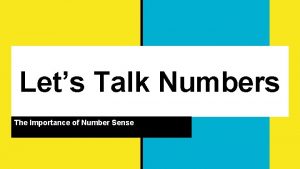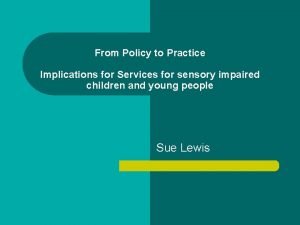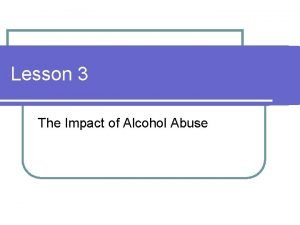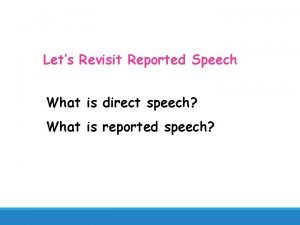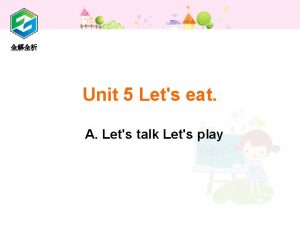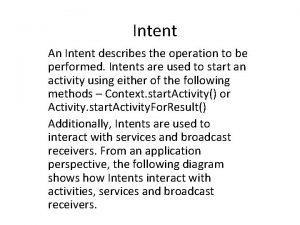Lets Talk Lesson 10 Intent Impact Intent doesnt




























- Slides: 28

“Let’s Talk” Lesson 10

Intent = Impact

Intent doesn’t always = Impact

Process of Communication Send Receive

“I know you believe you understand what you think I said, but I’m not sure what you heard is what I really meant. ”

Process of Communication Sending Pr oc es s Receiving Feedback ing P e c ro g n i ss

Sending and receiving messages more clearly are skills that can be developed with PRACTICE. First, become aware of what INTERFERES with messages!

Filters are things that get in the way when people talk to each other.

A filter is an interpretation of another person’s message based on their own experiences and expectations.

�Most filters are �Filters are how Learned. We See Things. �Filters can be Conditions About Us. �Everyone has filters and uses

Common FILTERS: 1. Conditions about us �(ex. : age differences) 2. Inattention/Distractions �(phone, noise, thinking about/doing something else. ) 3. Emotional States �(frustrated, worried, stressed, excited, etc. ) 4. Self-Protection � (in denial, defense, hiding issues or info)

More FILTERS: 5. Beliefs & Expectations �(silence = Doesn’t care, “useless” to discuss things) 6. Differences in style �(more, or less, verbal, doesn’t show feelings easily, etc. ) 7. Gender �(men & women have different ways of communicating. )


Verbal & Non-verbal communication combine to create meaning.

Verbal Skills Focus attention on making statement that build self-worth in others Build others up, rather than tear down When others feel better about themselves, they in turn become better listeners

Examples of confirming comments: �Acknowledgment of the thoughts, actions, or feelings of another person. �Being able to empathize with feelings being expressed by someone else �Clarifying responses by asking questions or gaining more information �Directing an agreeing response which allows the other person to feel validated �Expressing positive feelings – encouragement, support or genuine praise

Non-Verbal Communication Cues Outward signals that broaden another person’s understanding of what is being said. Behaviors that do not rely on written or spoken language to create meaning

How important are nonverbal messages? 1. A 1 st impression may be based more on someone’s nonverbal message 2. They have a major impact on how family members interpret each other’s behavior

How important are nonverbal messages? 3. Are the primary way people communicate feelings, attitudes, emotions 4. Are more BELIEVABLE than verbal messages (they are harder to hide) and

Listening…. Are you?

Listening involves: �Selecting what we want to hear from all the sounds that surround us �Attending to or focusing on specific information coming our way �Understanding what we hear by relating it to something we know �Remembering what has been said

Things in the way of listening: �Information overload; can’t take it all in �Wrapped up in personal concerns; can’t focus on others �Outside distractions (ex. phone) �Deciding something is not worth

“We have been given two ears and but a single mouth in order that we may hear more and talk less. ”

Guidelines for listening: �Be attentive to the speaker �Make eye contact �Be sensitive to feelings the speaker my be expressing verbally or non verbally �Let the speaker finish his/her statements before you answer

More Guidelines for listening: �Avoid being judgmental – you don’t have to agree with the other person in order to listen to them �Designate a future time for the conversation if too busy at the moment to listen �Make the arranged appointment a priority

Nonverbal Communication 1. Facial Expressions � surprise � fear � disgust � contempt � anger � sadness � happiness

Nonverbal Communication 1. 2. 3. 4. 5. 6. 7. 8. 9. Facial Expressions Gestures Paralinguistics Body Language and Posture Proxemics Eye Gaze Haptics Appearance Artifacts

Nonverbal Communication
 Implicit intent android studio
Implicit intent android studio Lets talk about sports
Lets talk about sports Uwe info hub
Uwe info hub Lets talk numbers
Lets talk numbers Intent implementation impact ofsted
Intent implementation impact ofsted The catcher in the rye jane gallagher
The catcher in the rye jane gallagher Doesnt really matter
Doesnt really matter What goes up and doesnt come down
What goes up and doesnt come down What kingdom do viruses belong to
What kingdom do viruses belong to Giann porn
Giann porn Which one doesnt belong
Which one doesnt belong King henry doesn't drink chocolate milk
King henry doesn't drink chocolate milk Dont tense
Dont tense Acamprasate
Acamprasate Talk, read, talk, write resources
Talk, read, talk, write resources Amateurs talk tactics professionals talk logistics
Amateurs talk tactics professionals talk logistics Problem talk vs solution talk
Problem talk vs solution talk Chapter 7 lesson 4 the war's impact
Chapter 7 lesson 4 the war's impact Impact lesson 3
Impact lesson 3 Lesson 5 the slave trade and its impact on africa
Lesson 5 the slave trade and its impact on africa Chapter 21 lesson 3 the impact of alcohol abuse
Chapter 21 lesson 3 the impact of alcohol abuse Paper that lets the light shine through
Paper that lets the light shine through The hartford times
The hartford times Lets copy saldanha
Lets copy saldanha Let's think in english
Let's think in english Let's see what you know
Let's see what you know Lets reported speech
Lets reported speech Let's review cartoon
Let's review cartoon Lets just kiss and say goodbye lyrics
Lets just kiss and say goodbye lyrics
